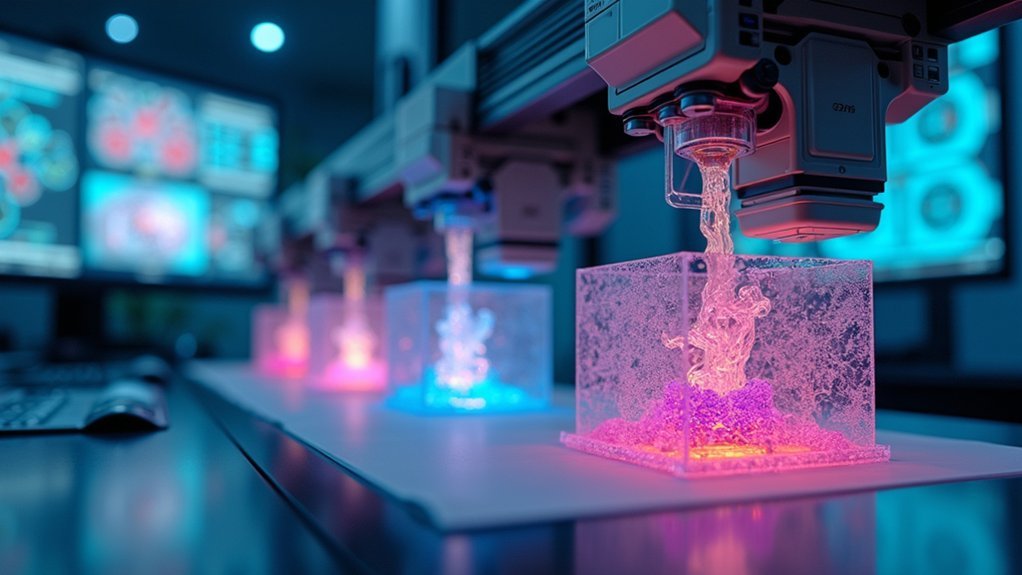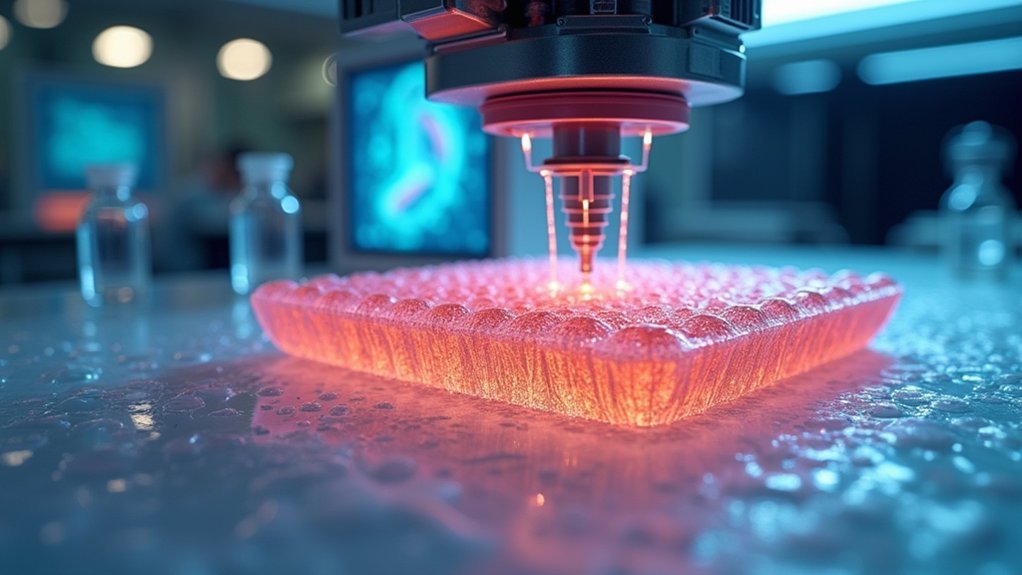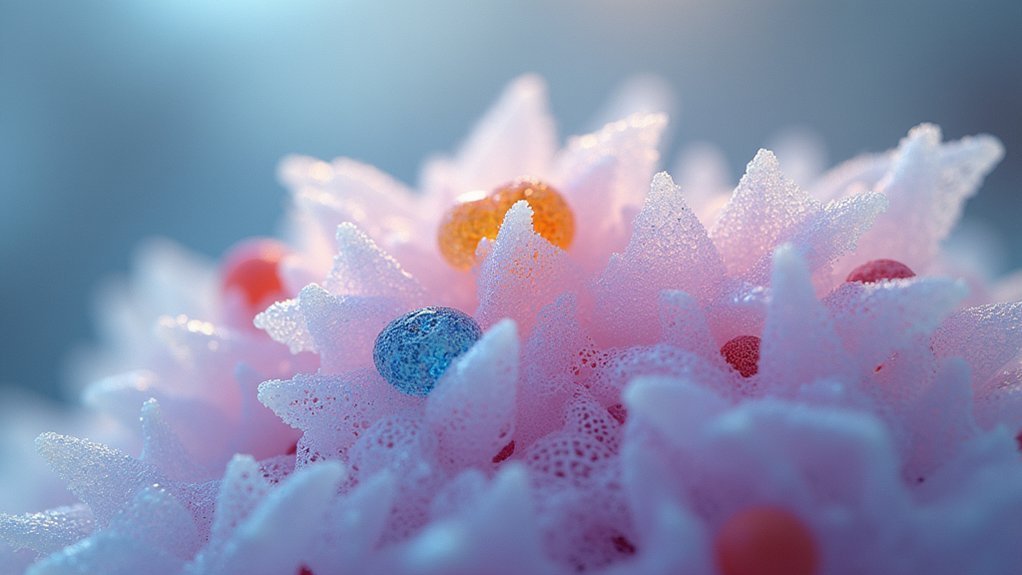You’ll gain unprecedented precision control over scaffold architecture when you choose bioprinting, achieving resolutions under 30 µm while seamlessly integrating living cells and bioactive molecules during fabrication. This technology creates complex vascular networks that boost cell survival rates by 30%, while customizable pore sizes optimize nutrient flow and cell migration. You can tailor scaffolds to patient-specific geometries and degradation rates, transforming tissue engineering into precision medicine that delivers superior clinical outcomes and enhanced healing timelines for diverse patient populations.
Precision Control Over Scaffold Architecture and Design Parameters

When you’re designing tissue scaffolds through bioprinting, you’ll gain unprecedented control over architectural parameters that directly influence cellular behavior and tissue development.
Bioprinting technology enables you to layer bioinks in complex geometries that replicate native tissue structures with remarkable precision control. Through CAD modeling, you can customize scaffold architecture by adjusting pore size and shape parameters that optimize cell migration and nutrient flow pathways.
You’ll achieve resolutions under 30 µm using advanced techniques like laser-assisted bioprinting, creating scaffolds with exceptional detail and fidelity.
Integration of Living Cells and Bioactive Molecules During Fabrication
Beyond architectural precision, bioprinting’s true potential emerges through its ability to seamlessly integrate living cells and bioactive molecules directly during the fabrication process.
You’ll achieve controlled spatial distribution of cells within your scaffold, enhancing cell interactions and tissue functionality. Advanced bioinks containing cells and bioactive compounds maintain high viability while mimicking natural extracellular matrix conditions.
Advanced bioinks enable precise cellular positioning while maintaining optimal viability and replicating natural extracellular matrix environments for enhanced tissue functionality.
You can incorporate growth factors and signaling molecules that support cell survival and promote tissue regeneration throughout printing.
Coaxial nozzle techniques let you simultaneously deliver bioactive molecules alongside living cells, optimizing nutrient diffusion.
You’ll customize bioink composition and concentration for targeted therapeutic applications, ensuring your scaffold’s biological performance matches specific tissue requirements and accelerates healing processes.
Advanced Materials and Bioink Formulations for Enhanced Performance

You’ll find that synthetic polymers like polycaprolactone offer superior mechanical strength and durability compared to natural alternatives, making them ideal for load-bearing tissue applications.
Natural bioinks such as gelatin and hyaluronic acid provide exceptional biocompatibility and promote cellular activities like adhesion and proliferation.
When you combine these materials strategically, you’re able to harness both the structural integrity of synthetics and the biological functionality of natural polymers.
Synthetic Polymer Advantages
Since synthetic polymers offer predictable properties and controlled manufacturing processes, they’ve become the backbone of modern bioprinting applications.
You’ll find that materials like PCL, PLA, and PLGA provide exceptional mechanical strength and biocompatibility while maintaining FDA approval for clinical use.
When you’re developing tissue scaffolds, synthetic polymers give you three key advantages:
- Unlimited design flexibility – You can create complex geometries that replicate natural extracellular matrix structures.
- Chemical customization – You’re able to modify polymer properties for enhanced printability and cell interaction.
- Enhanced performance integration – You can combine synthetic polymers with bioactive components to improve cell adhesion and proliferation.
These customizable hydrogels and bioink formulations let you tailor mechanical properties specifically for your application, ensuring superior scaffold performance.
Natural Bioink Properties
While synthetic polymers excel in mechanical strength and manufacturing control, natural bioinks bring unique biological advantages that can’t be replicated artificially.
You’ll find that natural bioinks, particularly hyaluronic acid derivatives, offer inherent biocompatibility and non-immunogenicity that synthetic materials struggle to match. Their shear-thinning behavior guarantees smooth extrusion during bioprinting techniques while preserving cell viability throughout the process.
You can optimize these materials’ rheological properties by adjusting concentration and molecular weight for specific tissue engineering applications.
Natural bioinks naturally promote cell adhesion and tissue regeneration through incorporated bioactive molecules. When you need enhanced mechanical properties and printability, structural modifications like esterification and amidation allow you to create more complex, durable constructs without sacrificing biological functionality.
Complex Vascularization Solutions for Nutrient Distribution Networks
As tissue constructs increase in size beyond a few millimeters, they’ll face the fundamental challenge of nutrient starvation and oxygen depletion at their core.
Bioprinting revolutionizes this limitation by creating sophisticated vascular networks that guarantee proper nutrient distribution throughout your scaffolds.
Advanced 3D bioprinting techniques offer precise control over vessel placement and architecture:
- Coaxial nozzle systems integrate microchannels that mimic natural blood vessels
- Growth factor incorporation promotes angiogenesis for enhanced tissue regeneration
- Controlled vessel spacing optimizes metabolic support across complex structures
These vascular architectures dramatically improve cell viability—studies show 30% higher survival rates compared to traditional constructs.
You’ll achieve better tissue integration and functionality as bioprinting enables the creation of intricate distribution networks essential for larger, more viable engineered tissues.
Customization Capabilities for Patient-Specific Tissue Requirements

When you leverage bioprinting’s customization capabilities, you’ll transform generic tissue engineering into precision medicine tailored specifically for each patient’s unique anatomy and physiological needs. You can utilize patient-derived cells to create biocompatible tissue scaffolds that match individual healing requirements, greatly improving outcomes. The technology enables you to design complex structures that replicate native tissue architecture, promoting ideal cell attachment and regeneration.
| Customization Feature | Patient Benefit |
|---|---|
| Patient-specific geometry | Perfect anatomical fit |
| Tailored bioinks | Enhanced mechanical properties |
| Custom degradation rates | Synchronized healing timeline |
You’ll access unlimited design possibilities through computer-aided modeling, allowing precise targeting of specific injury sites. Various bioinks can be incorporated and customized for different tissue types, enabling you to deliver truly personalized regenerative therapies.
Scalable Manufacturing for Clinical Translation and Commercial Viability
Because bioprinting technology must shift from laboratory prototypes to widespread clinical implementation, you’ll need manufacturing systems that can produce tissue scaffolds at scale without compromising quality or customization.
Scalable manufacturing transforms bioprinting into a commercially viable solution for clinical applications by ensuring consistent reproducibility across production cycles.
Your bioprinting system delivers three critical advantages for large-scale production:
- Automated biomaterials processing that maintains precise control over complex structures while reducing manufacturing costs
- Standardized protocols ensuring every tissue scaffold meets clinical-grade specifications for cellular functions
- High-throughput capabilities producing transplantable tissues that meet growing demand for tissue regeneration therapies
This scalability positions bioprinting as the definitive technology for addressing organ shortages, making personalized medicine accessible to broader patient populations while maintaining the precision required for successful clinical outcomes.
Frequently Asked Questions
What Is the Primary Advantage of 3D Bioprinting in Tissue Engineering?
You’ll gain precise control over scaffold geometry and cell distribution, enabling you to create highly customized tissue constructs that closely mimic natural structures while accelerating development from months to weeks.
What Is One of the Key Advantages of Using 3D Printing for Creating Scaffolds?
You’ll achieve complex geometric structures that mimic natural extracellular matrix when using 3D printing for scaffolds. This capability enhances cell behavior and tissue integration, providing significant advantages over traditional scaffold manufacturing methods.
What Are the Advantages of Bioprinting?
You’ll achieve precise control over scaffold composition and structure while integrating living cells directly. You can create complex geometries, rapidly prototype designs, and customize solutions using various bioinks for ideal biocompatibility.
What Is Scaffold in Bioprinting?
You’ll find scaffolds are three-dimensional structures that support cell attachment, growth, and differentiation in bioprinting. They’re made from synthetic or natural polymers, mimicking your body’s natural extracellular matrix environment.





Leave a Reply